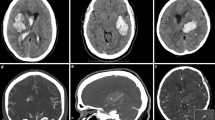Abstract
Background
A 78-year-old woman was transferred directly to an ICU because of intracerebral hemorrhage. However, on careful review of the initial imaging, the likely diagnosis was ischemic stroke and reperfusion hemorrhage.
Methods
Case report was explained.
Results
The patient suffered significant reperfusion hemorrhage. A CT angiogram revealed contrast extravasation “spot sign” in the bed of the expanding hemorrhage and an occlusive thromboembolism distal to the initial ischemic insult.
Conclusion
In this case of embolic ischemic stroke with reperfusion hemorrhage, contrast extravasation “spot sign” was associated with hematoma expansion.



Similar content being viewed by others
References
Barber P, Demchuk A, Zhang J, Buchan A. Validity and reliability of a quantitative computed tomography score in predicting outcome of hyperacute stroke before thrombolytic therapy. Lancet. 2000;355(9216):1670–4.
Mendelow AD, Gregson BA, Fernandes HM, Murray GD, Teasdale GM, Hope DT, Karimi A, Shaw MD, Barer DH, STICH investigators. Early surgery versus initial conservative treatment in patients with spontaneous supratentorial intracerebral haematomas in the International Surgical Trial in Intracerebral Haemorrhage (STICH): a randomised trial. Lancet. 2005;365(9457):387–97.
Mendelow AD, Gregson BA, Rowan EN, Murray GD, Gholkar A, Mitchell PM, STICH II Investigators. Early surgery versus initial conservative treatment in patients with spontaneous supratentorial lobar intracerebral haematomas (STICH II): a randomised trial. Lancet. 2013;382(9890):397–408. doi:10.1016/S0140-6736(13)60986-1.
Mould WA, Carhuapoma JR, Muschelli J, Lane K, Morgan TC, McBee NA, Bistran-Hall AJ, Ullman NL, Vespa P, Martin NA, Awad I, Zuccarello M, Hanley DF, MISTIE Investigators. Minimally invasive surgery plus recombinant tissue-type plasminogen activator for intracerebral hemorrhage evacuation decreases perihematomal edema. Stroke. 2013;44(3):627–34.
Wada R, Aviv RI, Fox AJ, Sahlas DJ, Gladstone DJ, Tomlinson G, Symons S. CT angiography “spot sign” predicts hematoma expansion in acute intracerebral hemorrhage. Stroke. 2007;38(4):1257.
Del Giudice A, D’Amico D, Sobesky J, Wellwood I. Accuracy of the spot sign on computed tomography angiography as a predictor of haematoma enlargement after acute spontaneous intracerebral haemorrhage: a systematic review. Cerebrovasc Dis. 2014;37(4):268–76.
Disclosures
Drs. Kramer and Rabinstein reports no disclosures.
Author information
Authors and Affiliations
Corresponding author
Rights and permissions
About this article
Cite this article
Scharf, E.L., Kramer, C.L. & Rabinstein, A.A. Hemorrhage or Ischemia? The Importance of ‘Spotting’ it Right. Neurocrit Care 23, 113–115 (2015). https://doi.org/10.1007/s12028-015-0113-1
Published:
Issue Date:
DOI: https://doi.org/10.1007/s12028-015-0113-1




